Email Marketing
Email and B2C Content Marketing: How to Maximize Your Strategy
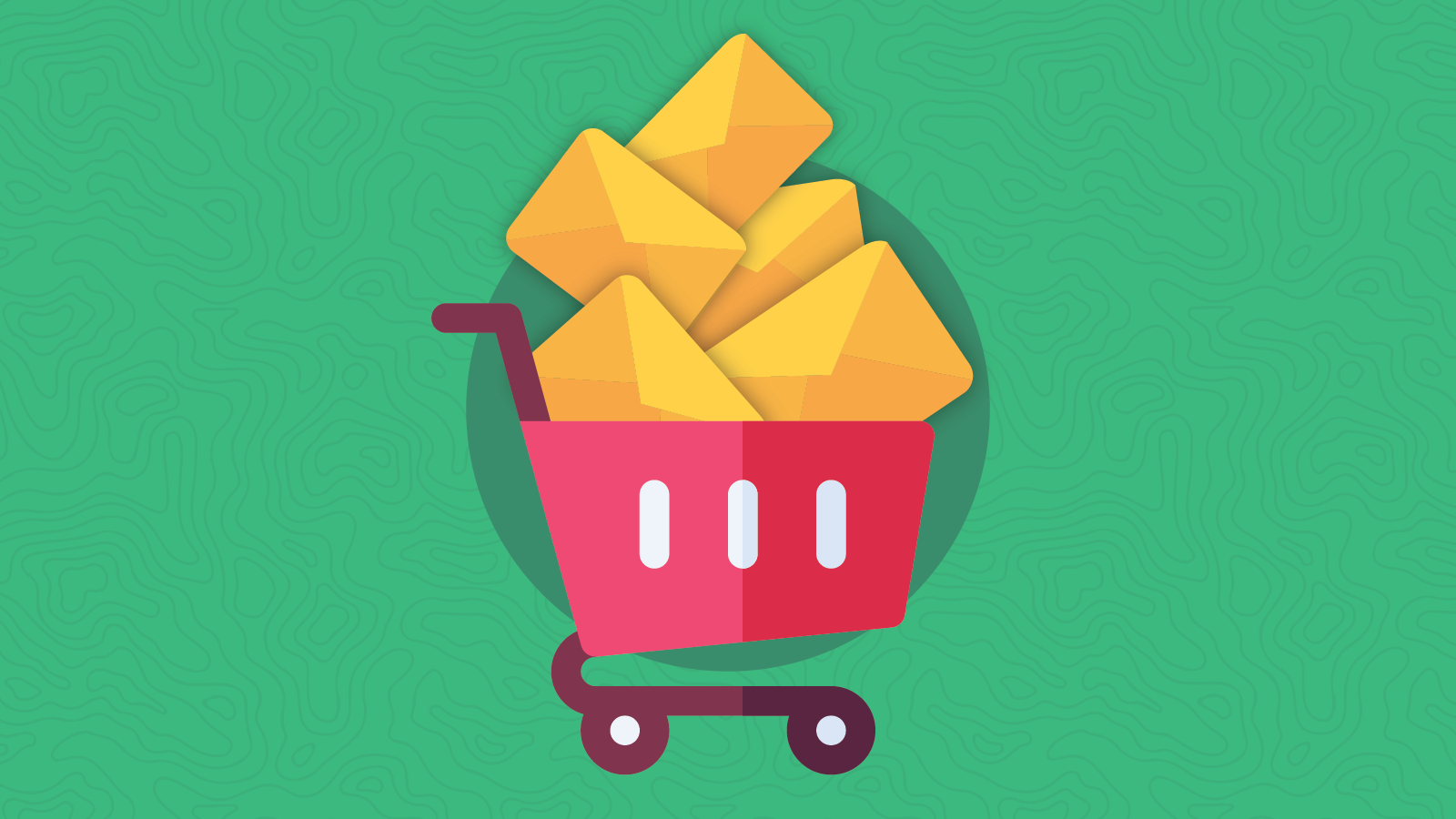
Email Marketing

Email and B2C content marketing go together like peanut butter and jelly. They’re better together.
Unfortunately, the two teams that are creating content and sending emails don’t always take the time to collaborate and communicate. That could mean missed opportunities for both email marketers and content marketers.
Worse yet, it could mean the two teams are operating under totally different marketing strategies. That’s a lot like a crew team trying to row their boat in two different directions at once. In that case, nobody is going anywhere.
By breaking down the silos between email and content marketing, both will become more effective in reaching, engaging, and converting consumers into loyal customers.
And you might already be feeling the need for this – in the 2022 B2C Content Marketing Benchmarks Report, 41% of B2C marketers named internal communications between silos/teams as one of their key challenges.
Break down the walls between the teams and figure out how to combine your efforts, and you’ll get better results. In other words, email isn’t just about selling, and content marketing isn’t just about information. Both need each other to do what they do best – engage and convert subscribers, visitors, and customers.
So, what else did the Content Marketing Benchmarks Report have to say about how email and B2C content are being used in marketing strategies?
For starters, 67% of survey respondents use email newsletters to distribute content, and 71% use email marketing software as part of their tech stack. This shows that the majority of marketers know that content and email should be working together.
Another 56% of B2C marketers use emails other than newsletters to distribute their content. That means marketing teams are using content more strategically than simply sending out the newest blog posts in the next email newsletter.
Email is also part of the mix when it comes time to measure the success of B2C content. CMI found that, at 63%, tracking email engagement was one of the top three ways that marketers gain insight into content performance. Only website metrics (67%) and conversions (65%) surpassed email marketing metrics.
Despite what seems to be a strong connection between email and B2C content marketing, there’s still a significant chunk of marketers who could be taking full advantage of email. CMI found that, in the last 12 months, B2C marketers were more likely to have used Facebook (88%), LinkedIn (78%), and Instagram (70%) to distribute content organically.
B2B content marketers tend to rely on email a bit more often than those marketing to consumers. A separate, companion report from CMI found that 74% of B2B marketers cited email as the most-effective channel for pushing out content.
Of course, it works both ways. Email marketers should find effective ways to use B2C content in different kinds of messages.
If you’re sending an email newsletter, but then using all your other emails for sales and promotions, your customers are missing out, probably getting a little weary, and not feeling as well-served as they wanted to be when they subscribed.
Ironically, you’re probably missing out on sales too. Consumers who are educated, informed, and entertained by content from your brand are more likely to be engaged and keep purchasing from you.
Email and content marketing should go hand in hand.
Email is the best channel for continually engaging with your top customers and prospects, and content is one of the best ways to do it. That’s because content solves problems, answers questions, piques interest, and invites participation. And email gets the right content to the right person at the right time.
But content marketers and email marketers need to work together in order to take advantage of that strong connection. Let’s look at why rowing in the same direction is so effective.
Search engines, social media, paid ads, and online influencers – those are just some of the ways a brand’s content can reach consumers. However, one of the big differences with distributing content through email is that you have more control over who sees it and when they get it.
While you can target a specific audience with paid ads and social media promotion, your email list is your target audience. You know the people receiving the content are going to be interested because they either signed up to get your emails or have already purchased from you.
They expect your content. They want your content. So, deliver it!
Likewise, anyone who finds your website and appreciates the content you’ve published is more likely to want more of it. High-quality content on your site assists your list-building efforts. With no content, how many people are likely to fill out that bare-bones opt-in form that has nothing of substance surrounding it to back up its promises?
31% of content marketers in CMI’s study said they use subscriber list growth as a key measure of content performance. That’s because if your content is good, people want it delivered directly to their inboxes.
High-quality content gets shared. And the people who are likely to share it the most are your email subscribers. These are your biggest fans. Your herd. Your people.
When you send them great content, they’ll be the most likely candidates to share it on social media and elsewhere. And when they do, you benefit from increased exposure and from backlinks that improve your search engine rankings.
We all get sick and tired of being sold to. Even when customers appreciate a company and buy from them regularly, nonstop selling becomes a bit of a drag. Eventually, those over-selly emails start to go unopened. That’s the first sign of a lagging customer or subscriber.
But when you make a habit out of using email for more than promotional purposes, the response will be positive. Now, the email is speaking to problems and challenges that your subscribers are dealing with in their businesses and lives. It’s sparking curiosity and even triggering a problem-solving mindset.
This type of email marketing content increases opens, clicks, shares, replies, and other forms of participation. Plus, it creates loyal customers who trust and respect your brand. So, they keep coming back for more.
CMI found that 42% of companies said one of their greatest challenges was creating content that appeals to different segments of their audience. This is yet another area in which content and email can help each other out.
One way to start improving the personalization of your email marketing content is to pay attention to who is clicking on what. And it works both ways. If your email list is segmented, content marketers can discover the topics that resonate with certain types of subscribers.
Share analytics between teams to gain audience insights that help optimize both the content and email strategies.
An educated subscriber is a subscriber who’s much closer to making a purchase decision.
Content is one of the most persuasive ways to explain the features and benefits of B2C products and services.
This can make future sales opportunities effortless. Whereas, if you just start wailing on them with sales offer after sales offer right after they join your list, you burn them out and turn them off.
As mentioned earlier, your email marketing content should be more than just newsletters and sales offers. And yet as you’ll recall, CMI found that 44% of B2C marketers aren’t using non-newsletter emails to distribute content. That’s a missed opportunity.
Here are five other ways to increase your content marketing through email.
What should you include in your welcome email marketing content?
A lot of B2C companies jump straight to coupons, giveaways, and special offers. And while there’s nothing wrong with that, think about what else you can send to your new email subscribers.
Do you have a special report they would appreciate? An excerpt from a podcast or book? A video that teaches them how to do something? A handful of blog posts that have proven to be your most popular?
Don’t just ask your brand new subscriber to buy, buy, buy. And don’t just send a single welcome email. Send a series. This way, you can give more than you ask. You can serve, solve problems, and make them feel welcome. Nothing does this better than content.
It’s all about balance. Notice how the cookware brand Made In sandwhiched a link to content with techniques and recipes in between promotional offers and new product. That’s smart because this email welcomes newsletter subscribers, and those contacts definitely want content.
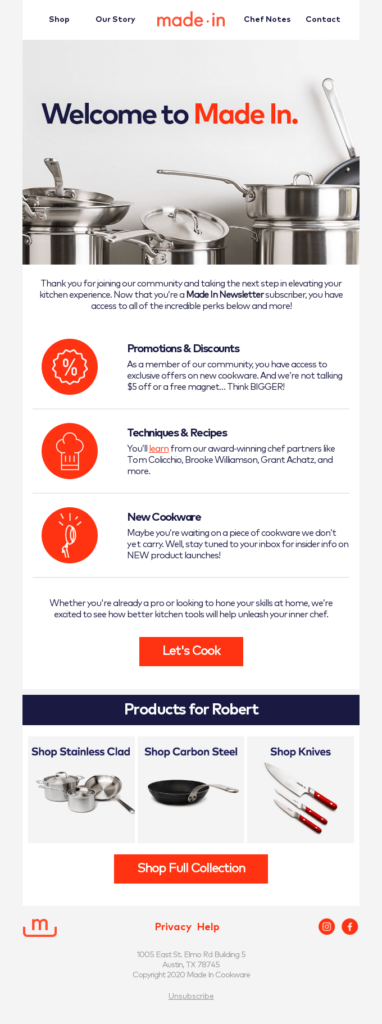
Speaking of selling, what’s one of the best ways to do this using email?
Let’s say you have a new vitamin supplement, or want to promote an existing one. One way to do this is to just send out emails selling the product. 20% off ought to do it, right? Except now you have to make up the losses from the coupon.
Instead, you could send out a link to an article explaining how to stay healthy during cold and flu season. One of the tips would be the supplement. Later, send out a video explaining how supplements help fight off various ailments. After that, find data on the time and money a person saves when they stay healthy, and compare that to the price of the supplement.
Do all that, and then send an email offering the supplement for sale. Now, you have educated your subscribers on the potential benefits of the supplement before you present the offer.
Now, the product is the answer they’ve been looking for, rather than something being shoved in their face.
Fullscript, for example, sent an email covering all the information someone might want to know about Vitamin D. While this content doesn’t directly sell anything, it informs subscribers of the benefits, which may lead to them purchasing supplements from Fullscript down the road. That’s how email and B2C content can boost sales.
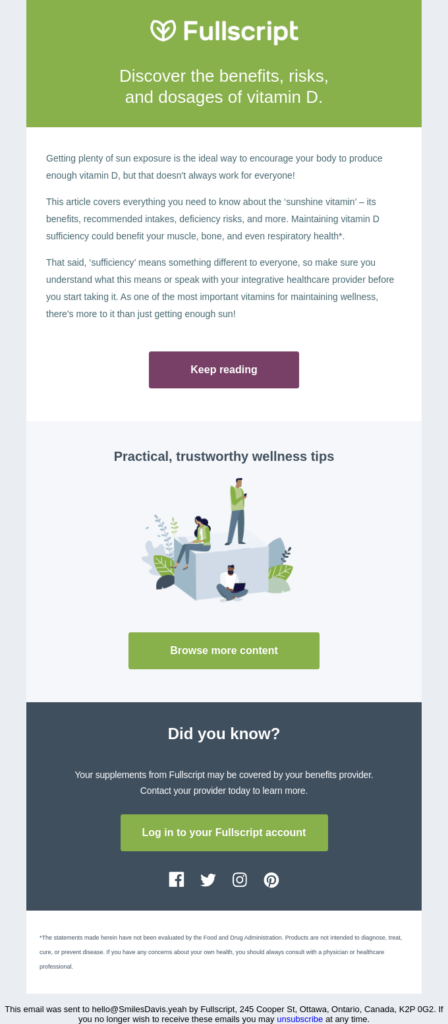
Drip campaigns offer another way to increase your segmented delivery of content through email. A welcome series is just one type of drip campaign. But you can create many others.
Consumer purchases that are expensive or represent a lifestyle change, such as new vehicles, new homes, or college education, require a lot of research. Email is the perfect channel for delivering helpful content that guides consumers on a customer journey that ends with them choosing your brand.
Let’s say that someone signed up for an eBook download about things to do in Costa Rica. You might send an email similar to this one from Essential Costa Rica, with targeted content specific to trip planning.
Or, suppose your website offers a PDF explaining how to remove mold from a basement.
What do we know about someone who downloads that PDF? They must have a mold problem! And they probably have a basement, too.
So you can safely follow up with anyone who downloads that using a series of emails offering even more content. Send a video showing how to clean mold, using a product that you sell. Send an infographic or step-by-step instructions on how to replace a wall that has been too damaged by mold to simply patch over. Show how products you sell can help fix various other problems in basements.
This is what Instead did. Except rather than teaching homeowners how to get rid of something, the email is all about getting more of something – beautiful grass.
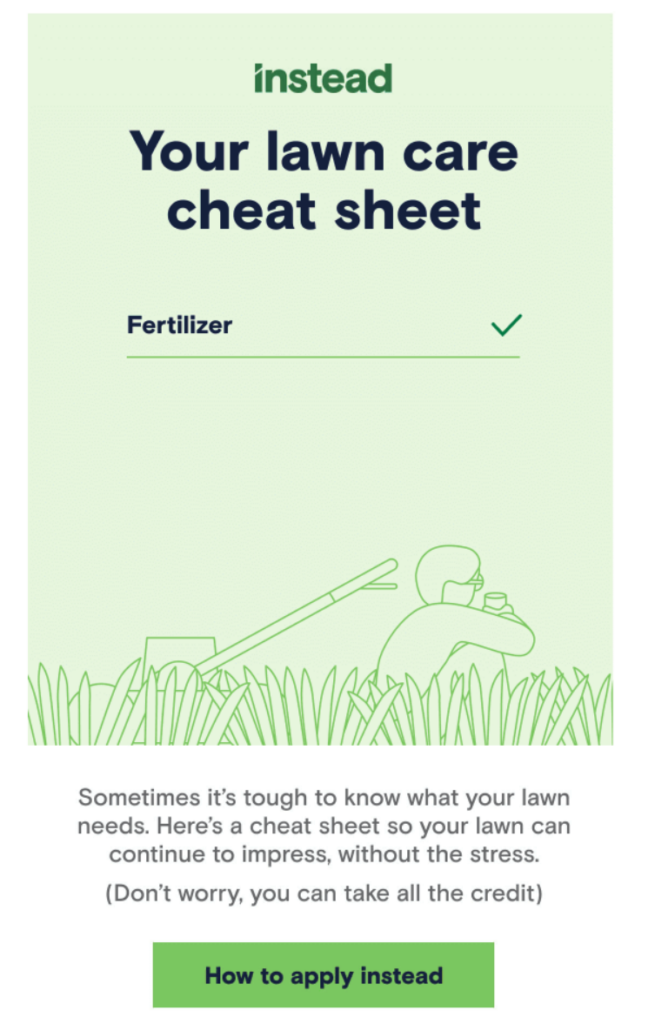
There are at least 15 types of email content drip campaigns you could create for various scenarios, including re-engagement, onboarding, promotions, education, courses, and training.
Speaking of re-engagement, look at your email data and create a segment of subscribers who haven’t clicked on anything in six months or more.
Send them a series of email marketing content that features your best posts from recent months, to show them what they’ve been missing. Some companies will list out the top five blog posts from the past month, for example. Or, share a special report subscribers may have missed.
Email and B2C content that addresses customer concerns and objections is also an excellent way to combine these channels. That’s what Headspace did in an email for customers who hadn’t been using the service – probably due to a perceived lack of time. (Subject line: Having trouble finding time to meditate?)
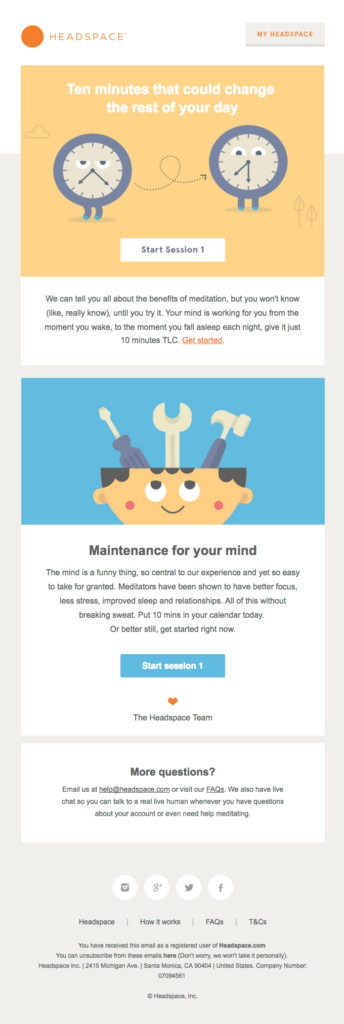
If you’re segmenting your email list, you can handpick content for those groups of subscribers, which makes campaigns much more relevant and meaningful.
Airbnb does a great job sending personalized content recommendations to travelers after they find a place to stay. The email below has content that would be valuable to someone visiting San Francisco.

Remember, the goal with email marketing content isn’t just to sell. It’s also to maintain and strengthen the relationship with each subscriber. Content is the single best way to achieve this on a consistent basis.
So get your content marketing people and your email marketing people in the same room. Convince them they should be friends and remind them they’re on the same team. Get off the battleship, get your oars, and start rowing together.
Speaking of email marketing content, how about us doing what we’re telling you to do?
If you found this article valuable, maybe you’d like to hear more. Get the Email on Acid newsletter, and receive more tips, strategies, data insights, and technical expertise related to email marketing, sending, deliverability, and more.
Or, if you want to jump straight to the deep stuff, here’s our collection of white papers and special reports. If you prefer video, check out our “Notes from the Dev” video series on YouTube.